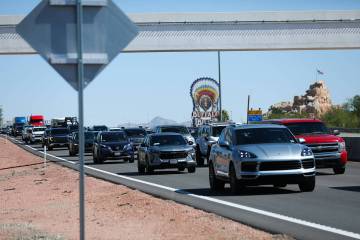NDOT using technology to make Nevada roads safer, more efficient
Road projects, especially ones on Las Vegas Valley freeways, usually include installing intelligent transportation systems technology.
If you’re like other readers who reached out to the Road Warrior, you might also be wondering what intelligent transportation systems technology, also known as ITS, entails, especially when such technology is mentioned in news stories, such as last week’s announcement of the start of a 215 Beltway widening project between Interstate 15 and Windmill Lane.
ITS, along with active traffic management (ATM) signs, are part of the Nevada Department of Transportation’s master plan to improve safety, mobility and the reliability of roads in the state.
It also includes various technology elements such as traffic cameras, dynamic messaging signs, road weather stations and traffic sensors that give NDOT and other agencies the ability to monitor traffic in real time and react accordingly to incidents on area roads.
Across Nevada, there are more than 1,200 traffic cameras, 850 detector stations, 350 dynamic message signs (different from the ATM signs), 140 road weather stations and 80 ramp meters.
ATM signs have been installed on portions of Interstate 15 and I-11, also known as U.S. Highway 95, since Project Neon was completed in late 2019. NDOT recently added 10 more signs to I-15 near Allegiant Stadium as part of the soon-to-be-completed I-15/Tropicana interchange project, to bring the total to 52 ATM signs located along the two freeways.
“ATM includes strategies like ramp metering and overhead lane control signs that actively manage traffic flow and improve safety,” NDOT spokeswoman Kelsey McFarland said in a statement. “Together, these tools help NDOT detect incidents quickly, respond efficiently, and keep drivers informed.”
The overhead ATM signs use clear symbols — such as red Xs for closed lanes ahead — to show open or closed lanes, while also having the ability to display messages warnings about backups, crashes or lane restrictions farther down the freeways.
“This system is designed to maintain safer, more consistent traffic flow — especially during incidents or construction,” McFarland said.
The ITS and ATM Master Plan lays out how NDOT will deploy and use technology to increase safety, reduce traffic congestion and improve emergency response times in the case of crashes or other on-road incidents.
The plan also falls into NDOT’s long-range planning, including the One Nevada Plan and Transportation Systems Management and Operations.
“The plan evaluates Nevada’s current ITS infrastructure, identifies technology gaps, and recommends where and how to expand these systems over time, with a phased implementation timeline across short-, mid-, and long-term priorities,” McFarland said.
Contact Mick Akers at makers@reviewjournal.com or 702-387-2920. Follow @mickakers on X. Send questions and comments to roadwarrior@reviewjournal.com.


















